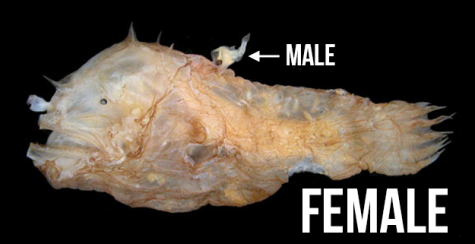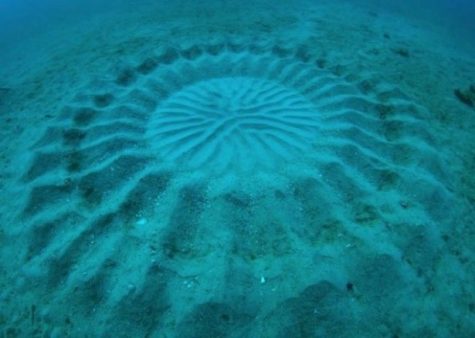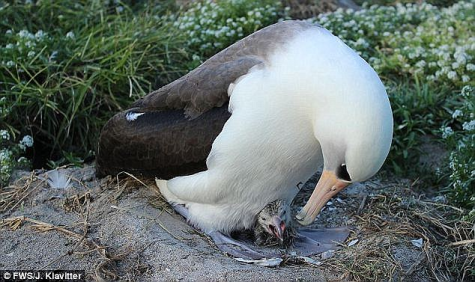Animal of the Week: Nature’s Weirdest Lovers

February 23, 2018
By Sam Schwartz ’18, Sports Editor
The “Animal of the Week” will show the amazing biodiversity that nature has to offer. These animals won’t be your typical wild Zebras, Sharks, and Bears-but some of the most endangered and magnificent animals on the planet.
*This week, in honor of Valentines Day last week, I decided to highlight some of the more bizarre relationships in the animal kingdom.
First, we will begin our adventure in the deep dark depths of the open ocean, where our lovers inhabit. The Deep-Sea Angler (Melanocetus johnsoni) is a relatively small round black fish compared to its colossal depiction in the childhood favorite Finding Nemo (Shockingly, it reaches a maximum length of about five inches). It swims around in the dark abyssal plains, wielding its namesake angler, which is a light producing sac on the end of a specially elongated dorsal spine–called a photophore. The Deep-Sea Angler has one of the most unusual means of reproduction. Though sexual dimorphism, which just means males and females have different traits, is common in the animal kingdom, it is usually not as severe as with the Deep-Sea Angler. Females are the dominant sex and grow up to five inches. Yet, the males max out to about the size of a peanut. Males swim in search of the females, and once they find one, bite down on them. The male physically attaches himself to her. Then through a chemical produced by the male, his mouth is sealed closed to the skin of the female, there blood supply combines, and the male shrivels up. He leaves only his reproductive organs behind. That is a “successful” life of a male angler. He becomes an automated egg-fertilizing machine. Whenever the female produces a fresh set of eggs, instead of wasting precious energy searching for a mate, instead of hunting, she can use the already attached male for fertilization. Scientists believe that Angler’s use this strategy called “sexual parasitism” because the probability that two fish will run into each other at the right time is so miniscule. Scientists believe the ratio of males per female angler fish is one male and female to every 327,000 cubic feet of water, approximately like a single hotdog looking for a single peanut in the size of Paul Brown Stadium.
means males and females have different traits, is common in the animal kingdom, it is usually not as severe as with the Deep-Sea Angler. Females are the dominant sex and grow up to five inches. Yet, the males max out to about the size of a peanut. Males swim in search of the females, and once they find one, bite down on them. The male physically attaches himself to her. Then through a chemical produced by the male, his mouth is sealed closed to the skin of the female, there blood supply combines, and the male shrivels up. He leaves only his reproductive organs behind. That is a “successful” life of a male angler. He becomes an automated egg-fertilizing machine. Whenever the female produces a fresh set of eggs, instead of wasting precious energy searching for a mate, instead of hunting, she can use the already attached male for fertilization. Scientists believe that Angler’s use this strategy called “sexual parasitism” because the probability that two fish will run into each other at the right time is so miniscule. Scientists believe the ratio of males per female angler fish is one male and female to every 327,000 cubic feet of water, approximately like a single hotdog looking for a single peanut in the size of Paul Brown Stadium.
 Rising from the deep, our next lovable relationship occurs just of the shores of Japan. Noticed in 1995, odd crop circles were found by local Japanese divers. At first, scientists believed that the patterns were formed by underlying ocean currents. Years later, scientists came upon a circle with a tiny pufferfish, a white spotted pufferfish, resting above it. As the scientists moved closer, the pufferfish became aggressive and lunged at them. As they swam away they disturbed the pattern, and when they turned around, they saw the pufferfish quickly fixing the crop circle, and thus our mystery was solved. This merely five-inch fish (Arathron hispidus), creates unique circles of over seven feet in length, all in hopes of attracting a female. When a female passes by, she inspects the circle. If she is impressed, she will mate with the male. Yet scientists still aren’t sure what exactly the female pufferfish are looking for, whether it be shape, size, or thickness.
Rising from the deep, our next lovable relationship occurs just of the shores of Japan. Noticed in 1995, odd crop circles were found by local Japanese divers. At first, scientists believed that the patterns were formed by underlying ocean currents. Years later, scientists came upon a circle with a tiny pufferfish, a white spotted pufferfish, resting above it. As the scientists moved closer, the pufferfish became aggressive and lunged at them. As they swam away they disturbed the pattern, and when they turned around, they saw the pufferfish quickly fixing the crop circle, and thus our mystery was solved. This merely five-inch fish (Arathron hispidus), creates unique circles of over seven feet in length, all in hopes of attracting a female. When a female passes by, she inspects the circle. If she is impressed, she will mate with the male. Yet scientists still aren’t sure what exactly the female pufferfish are looking for, whether it be shape, size, or thickness.
Our next story brings us out of the reefs and lands us on a small island off the coast of New Zealand. There, we will find Wisdom, the world’s oldest documented bird, at the ripe age of sixty-six. She, like many of her Laysan Albatross (Phoebastria  immutabilis) brethren are monogamous, meaning they mate for life. Unfortunately, due to Wisdom’s old age, she has had multiple partners over her life time, yet has still managed to successful hatch thirty-six fledglings (pictured right). With each partner, at the beginning of the mating season, Laysan Albatrosses land in the same spot and display their own unique dance ritual These dances take years to perfect by adolescent Albatrosses, so until they can perfect their dances they cannot mate.
immutabilis) brethren are monogamous, meaning they mate for life. Unfortunately, due to Wisdom’s old age, she has had multiple partners over her life time, yet has still managed to successful hatch thirty-six fledglings (pictured right). With each partner, at the beginning of the mating season, Laysan Albatrosses land in the same spot and display their own unique dance ritual These dances take years to perfect by adolescent Albatrosses, so until they can perfect their dances they cannot mate.


